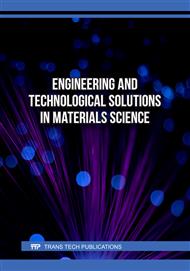[1]
M. Ari, B. Saatci, M. Gunduz, F. Meydaneri, M. Bzoklu, Microstructure and thermoelectrical transport properties of CdSn liquid alloys, Mater. Charact. 59, (2008), 624- 630
Google Scholar
[2]
R.Hultgren , P.D. Desai, D.T. Hawkins, M. Gleiser K.K. Kelley , Selected Values of the Thermodynamic Properties of Binary Alloys, ASM, Metal Park, Ohio, (1973)
Google Scholar
[3]
R.N. Singh, F. Sommer, Segregation and immiscibility in liquid binary alloys, Rep.Prog. Phys 60, (1997), 57-150
DOI: 10.1088/0034-4885/60/1/003
Google Scholar
[4]
D.S. Evans, A. Prince, The thermal analysis Sn-rich CdSn alloys, Thermochemica Acta, 58(2),(1982), 199-209
DOI: 10.1016/0040-6031(82)87082-2
Google Scholar
[5]
J. Dulkiewicz, L. Zabdyr, Z. Moser, J. Salawa, The Cd-Sn (Cadmium-Tin) system, Bull. Alloy Phase Diagrams 10(3),(1989),223- 229
DOI: 10.1007/bf02877499
Google Scholar
[6]
S.K. Tarby, A comment on CdSn system, Bull. Alloy Phase Diagrams 11,(1990), 103-106
Google Scholar
[7]
A.M. Vora, Electrical transport properties of liquid Cd-binary alloys, J. Ovonic Research 3 (3), (2007), 57-66
Google Scholar
[8]
P. Terzieff, The viscosity of liquid alloys, J. Alloys and Compd. 453, (2008), 233-240
Google Scholar
[9]
A. Quin, R. Wang, Y. Wang, J. Wang, S. Liu, K. Chang, Y. Du, B. Sundman, Thermodynamic assessment of the Cd-X ( X= Sn, Mn, Fe) systems, Calphad 47, (2014),83-91
DOI: 10.1016/j.calphad.2014.06.006
Google Scholar
[10]
P. Fima, R. Novakovic, Surface tension modelling of liquid Cd-Sn-Zn alloys, Phil. Mag. 89, (2018), 1608- 1624
DOI: 10.1080/14786435.2018.1448124
Google Scholar
[11]
R.P. Koirala, I. Koirala, D. Adhikari, Energetics of mixing and transport phenomena in Cd-X (X= Pb, Sn) melts, BIBECHNA 15, (2018), 199-209
DOI: 10.3126/bibechana.v15i0.18751
Google Scholar
[12]
N. Barbin, I. Tikina, D. Terentyev, Thermodynamic modelling of melt of the Bi-Pb-Sn system, J. Conf. Series 2057, (2021), 012104
DOI: 10.1088/1742-6596/2057/1/012104
Google Scholar
[13]
E.O. IlO-Okeke, B.C. Anusionwu, O.Popoola, Thermodynamic evaluation of viscosity in In-Zn and Sn-Zn liquid alloys, Phys. Chem. Liq. 43,(2005), 333-342
DOI: 10.1080/00319100500087964
Google Scholar
[14]
G.K. Shrestha, B.K. Singh, I.S. Jha, B.P. Singh, D. Adhikari, Optimization method for the study of the properties of Al—Sn binary liquid alloys, Physica B 514, (2017), 1-7
DOI: 10.1016/j.physb.2017.03.005
Google Scholar
[15]
Rajendra Prasad Chaudhary, Jagdhar Mandal, Indu Shekhar Jha, Symmetries in the properties of mixing of AgCu liquid alloys at 1423 K, Materials today: Proceedings, 49(5), 2022, 2283-2287
DOI: 10.1016/j.matpr.2021.09.343
Google Scholar
[16]
Rajendra Prasad Chaudhary, Jagdhar Mandal, Indu Shekhar Jha, Concentration dependence of the bulk and surface properties of liquid AlZn alloys at 1400 K, Materials Today: Proceedings 59(1), 2022, 397-404
DOI: 10.1016/j.matpr.2021.11.358
Google Scholar
[17]
E.A. Guggenheim, Mixtures, Oxford University Press, London, (1952)
Google Scholar
[18]
A.B. Bhatia and D.E Thornton, Structural Aspects of the Electrical Resistivity of Binary Alloys, Phys. Rev. B, Phys. Rev. B 2, (1970), 3004-3012
DOI: 10.1103/physrevb.2.3004
Google Scholar
[19]
R.N. Singh, Can. J. Phys. 65 , (1987), 309-325
Google Scholar
[20]
B.E. Warren, X-ray Diffraction , Reading M.A., Addition-Wesley Pb. , (1969)
Google Scholar
[21]
J.M. Cowley, An Approximate Theory of Order in Alloys, Phys. Rev. 77, (1950), 667-675
Google Scholar
[22]
L.S. Darken, Trans. Metall. Soc. AIME 239, (1967), 80-89
Google Scholar
[23]
T. Iida, R.I.L. Guthrie, The Physical Properties of Liquid Metals, Clarendon Press, Oxford, (1988)
Google Scholar
[24]
O.E. Awe, A.A. Azeez, Temperature dependence of the bulk and surface properties of liquid Zn-Cd Alloys, Appl. Phys. A: Materials Science and Processing 123,(2017),1-10
DOI: 10.1007/s00339-017-0977-3
Google Scholar
[25]
A.P. Singh, R.P. Chaudhary, Rupam Kumari, I.S. Jha, Stability of NaK Liquid Alloys at Defferent Temperatures, J. Mandal, Material Today: Proceedings, 66(4), 2022, 2251-2258
DOI: 10.1016/j.matpr.2022.06.097
Google Scholar


